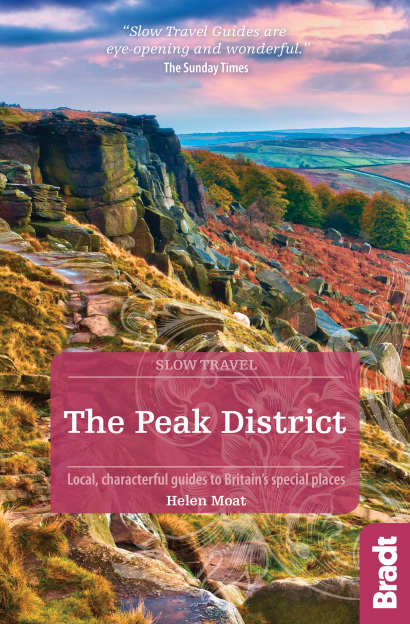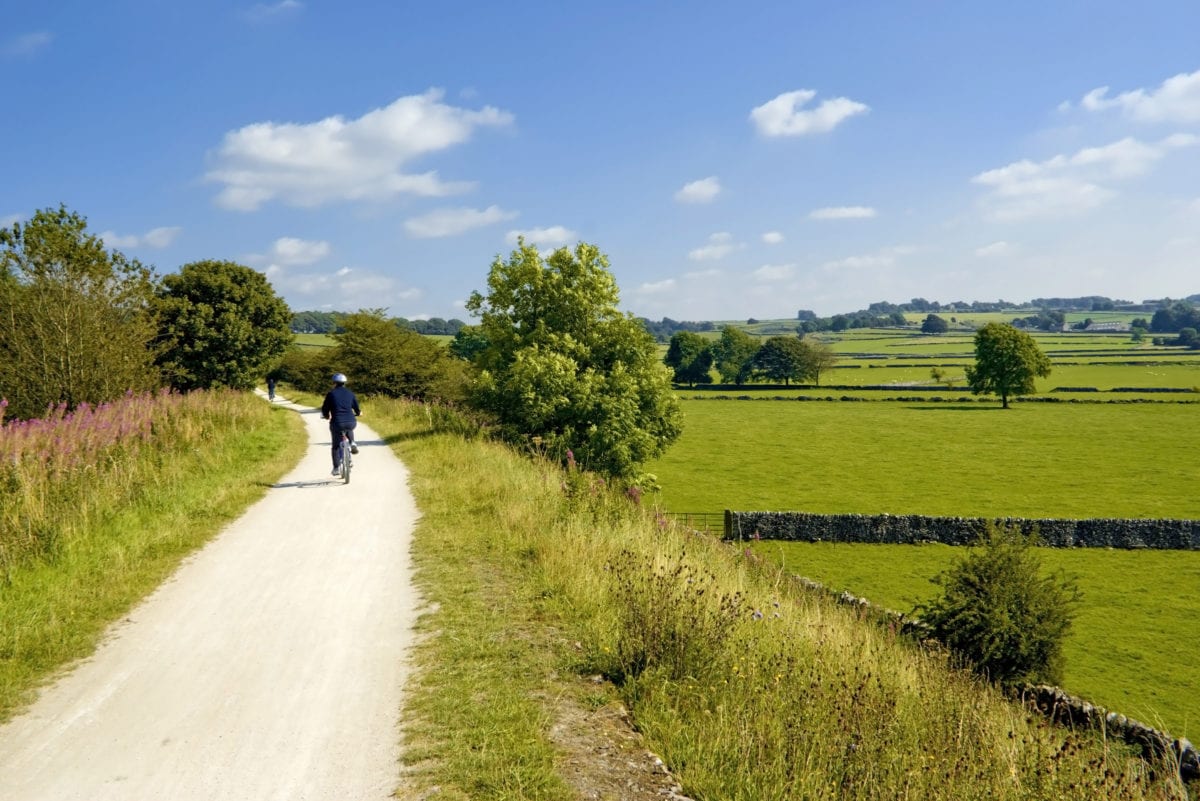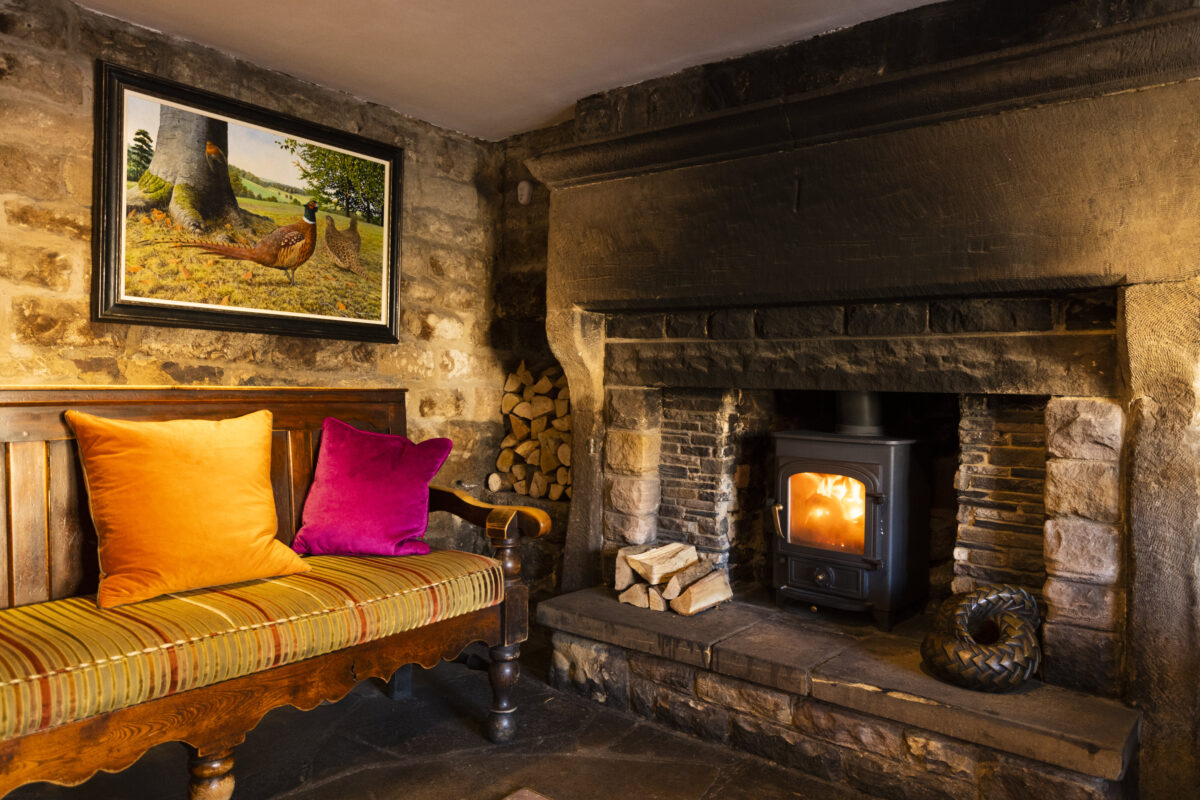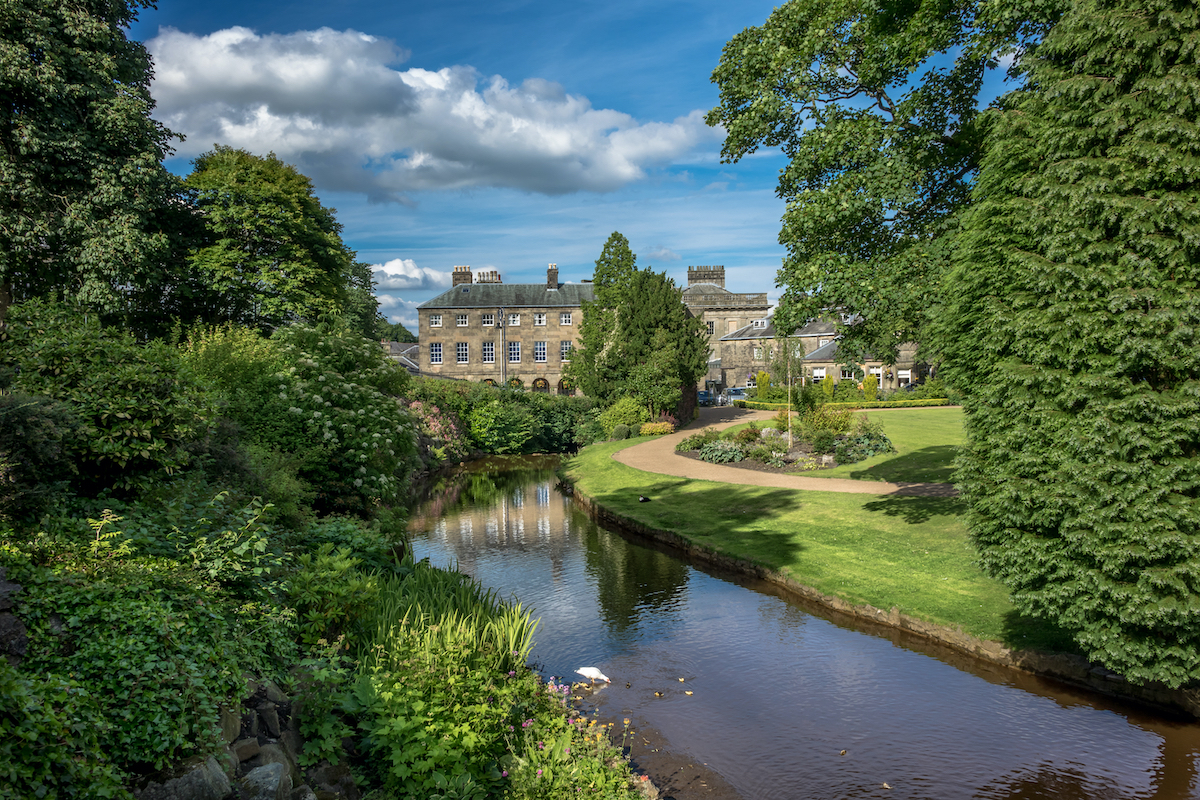There’s a sense of homecoming in the Peak District uplands – a slowing down and returning to our ancestral roots.
Helen Moat, author of Slow Travel Peak District: the Bradt Guide
In the Peak District, the visitor can slow down and return to a simpler existence. Where the Dark Peak stretches from Saddleworth to Kinder, continuing southward, east and west of the White Peak, the moorlands provide ramblers with mile upon mile of near wilderness.
Here, bog gives beneath the boot and the air is filled with the scent of turf and the call of the curlew. This seemingly featureless moorland is only interrupted occasionally by mysterious stone circles, Bronze-age forts, reservoirs, cloughs, brooks, tors or edges.
When the modern soul yearns for civilisation again, northern settlements such as Saddleworth, Holmfirth and Marsden offer bustling tourist centres and year-round festivals, while the gritty industrial towns of Glossop, New Mills, Macclesfield and Leek to the west combine impressive Victorian engineering with long-established markets.
Cradled by the gritstone, the White Peak is a softer, more diverse landscape of wooded dales, meandering rivers and upland pasture. Man has made a stronger mark here, the landscape chequered with dry-stone walls punctuated with tiny barns – a pleasing geometrical order in the natural environment. On the limestone, the market towns of Bakewell and Buxton serve countless sleepy villages that shake themselves awake in the session of fetes, festivals, well dressings and open gardens. Whether wandering through ancient monuments, Victorian mills, stone-built settlements, wooded dale or empty moorland, there’s a sense of homecoming in the Peak District uplands – a slowing down and returning to our ancestral roots.
Bradt on Britain – our Slow Travel approach
Bradt’s coverage of Britain’s regions makes ‘Slow Travel’ its focus. To us, Slow Travel means ditching the tourist ticklists – deciding not to try to see ‘too much’ – and instead taking time to get properly under the skin of a special region.
You don’t have to travel at a snail’s pace: you just have to allow yourself to savour the moment, appreciate the local differences that create a sense of place, and celebrate its food, people and traditions.
For more information, check out our guide to the Peak District
When to visit the Peak District
January
Mountain hares on Bleaklow
Start the New Year with a ramble on Bleaklow. Where better to walk off any Christmas excesses than on this high level moorland massif – with possible sightings of the mountain hare now dressed in its snowy-white winter coat. Map-reading skills, compass, boots and suitable outdoor clothing are all required.
February
Eat, drink and be merry in the Arts and Crafts town of Leek
Stave off the winter blues and head for Leek Food and Drink Festival. It’s worth extending your stay to take in Leek’s other markets: apart from the food stalls stacked high with local produce, there’s the historical Butter, Trestle and Charter markets selling everything from crafts to collectables. For those who want to feed their soul, grab the Architecture Trail pamphlet and discover the art and design of Morris & Co tucked away in Leek’s backstreets, public buildings and churches.
March
Around Ashbourne
This is a good time to explore Ashbourne and Dovedale – when the crowds have melted away. Flanked by crinkle-cragged hills (once tropical reefs) and rocky pinnacles, it’s easy to see why Dovedale is a honeypot in the high season. If the rain is lashing down, check out the beautiful churches of St Oswald’s in Ashbourne, St Edmunds in Fenny Bentley and the Church of the Holy Cross in Ilam – all within a few miles of each other. They’re crammed with local history, interesting tombstones and story-filled stained-glass windows.
April
Woodland bluebells and birdsong
In Marsden, the locals celebrate the end of winter with the Cuckoo Festival. April is a wonderful time to explore the Peak District woodlands, when nature comes to life. Birdsong fills the air and wild flowers start to push their way through the rain-softened earth – wood sorrel, anemones and bluebells. Bow Wood at Lea Bridge offers a very fine wildflower walk with bluebells carpeting the open hillside as well as under the trees.
May
Well dressings and open gardens
The Peak District villages are at their best in early summer – starting in May when the well dressing and open garden season commences. Wells and fountains are dressed with pictures of local scenes, recreated with petals and seeds. From late May, lovingly tended gardens and vegetable plots are opened up to the public. Relax in a cottage garden with a cream tea.
June
The Peak District from a bike
This is the time to pedal along the dismantled railway tracks. The Monsal, High Peak and Tissington trails are at their best in June, the verges splashed with the colour of wildflowers and herbs. For those who like all things vintage, the Eroica Britannia Festival in Bakewell gives you the chance to dig out that old bike and don some plus-fours before heading out into the Peak countryside. Along with retro cycling, the three-day festival offers street food, stalls, music and entertainment.
July
Buxton Festival
Music, drama, opera, comedy, literature and story-telling, it’s all happening in the spa town of Buxton – a fine setting for an arts festival with its elegant opera house, pavilion gardens and grand dome.
August
Moorland colour
Mid to late August is the time to head for the Dark Peak when the uplands are covered in purple heather. From the edges above Hathersage, Grindleford and Baslow to the Pennine Way that cuts across Marsden Moor, Bleaklow and the Kinder Massif, the paths offer extensive views across the rolling moorland now awash with colour.
September
Wirksworth Arts Festival
Paintings, art installations, sculpture, pottery, music and street entertainment at are all to be found around the centre of Wirksworth and in the ‘jitties’ above the town during the Wirksworth Arts Festival. Drop into the hillside cottages for a cup of tea and a cake and wander through the tiny puzzle gardens cut adrift by the maze of narrow paths – and view the exhibits at your leisure.
October
Music and all that jazz
The days are short and the nights long, so October is a good time to draw up your chair at a pub fireside and listen to live music. From the Fishpond in Matlock Bath to the Three Stags at Wardlow Mires, you’re spoilt for choice in the Peak District. Best of all, perhaps, is the Marsden Jazz Festival offering up a fine cocktail of folk, blues and jazz music.
November
Winter walks in the grounds of stately homes
Wrap up warm and choose a bright, sunny day to walk in the grounds of the Peak District’s stately homes, now that most of the tourists have gone home. Chatsworth House and Lyme Hall offer acres of woodland and open parkland, dotted with hunting towers and herds of deer. Rent one of the available estate cottages and enjoy a winter break in the solitude of the estate park and woodland.
December
Christmas in Castleton
The whole of Castleton is illuminated with festive lights throughout December. Late night openings offer atmospheric Christmas shopping, while Treak Cliff and Peak Caverns on the edge of town put on candlelit carol singing and concerts accompanied by mulled wine and mince pies. If you’re in luck, the hills above town might even be covered in snow.
What to see and do in the Peak District
The Dark Peak
On the map, the Dark Peak with its underlying gritstone and dark peat moorland stretches out as a thrilling expanse of wilderness with just the occasional road cutting across it, along with the wriggly blue and orange lines of streams and contours. This area of upland isn’t really empty of course, but teems with all manner of non-human life – from buzzards and peregrines to golden plover, curlew and grouse, while the moorland is packed with bog mosses, lichens and cottongrasses – and the insects and animals that inhabit it. Here you’ll encounter real wilderness walking and the opportunity to slow down and clear your head of all the noise that comes with modern life. Views extend in every direction, only interrupted by rocky tors and wooded cloughs.
Gathered around the moorlands, just outside the national park border, are the old mill towns and villages of Marsden, Holmfirth, Greenfield, Uppermill and Glossop, reinvented as tourist destinations. They still retain their northern grit and long-established traditions while catering for visitors with boutique shops, welcoming tea rooms and delightfully low-key tourist attractions.
The map is daubed with the blue blobs of the reservoirs that pad out the valleys and stretch out along the fringes of the national park. The reservoirs were created to feed the insatiable mills and industries of the towns and villages that surround the Peak Park, and to quench the thirst of the growing populations. There are 34 reservoirs in the Peak District, the vast majority situated in the Dark Peak. Not only do they provide clean drinking water but they double up as a watery playground, offering everything from sailing, canoeing and cycling to rambling and birdwatching. Some of them receive hundreds of thousands of visitors every year (like the Derwent Valley reservoirs), while others like Damflask and Agden around the Bradfields are less accessible with little or no amenities, and see only the occasional walker. As with the empty moorland, these quiet expanses of water are great places to reconnect with nature.
The Derbyshire Peak Fringe & Lower Derwent
Along the southeast border this remarkably diverse area lies just outside the national park, but it contains all the character of the Peak District. It includes the gritty Derwent Valley Mills with soaring chimney stacks to the gorges and rocky bluffs of the Matlocks, and a quiet hinterland of sleepy villages tucked into the folds of farmland. The Lower Derwent Valley is peppered with industrial heritage: mills, canals, dammed lakes, rivers, leats, lynchpins and water wheels, evoking a seismic shift in Britain’s economic and social landscape – the Industrial Revolution, when this corner of the Peak District witnessed the arrival of the factory system. The Derwent Valley Mills scattered along the A6 are a UNESCO World Heritage Site, recognising the part the Lower Derwent played in changing the world forever. Around the valley on hill and in dale, however, are the tell-tale remnants of earlier ages: the pockmarks of lead mineshafts; the crumbling stone barns caught between dry stone walls; the rise and dip of ridge and furrow fields, and the long-windowed workshops of the cottage industry. In between are the opulent halls and stately homes of Derbyshire’s industrialists such as Arkwright, Smedley and Nightingale.

Industrialisation also brought benefits to the masses during the Victorian era in the form of tourism. Industrial heritage aside, there is much else to see and do in this corner of the Peak District. The pleasure gardens, parks, hydro hotels and pavilions still adorn Matlock and Matlock Bath today with their faded elegance. The hills and dales are criss-crossed with public footpaths, including the glorious Limestone Way, while the market towns of Cromford and Wirksworth will tempt you with their arty cafés, boutiques and architectural heritage.

The Eastern Moors
Stately homes and handsome halls such as Chatsworth House and Haddon Hall are scattered along the Eastern Moors, tucked into valleys and flanked by woodland, or backed by great escarpments and moorland wilderness. The aristocracy, spending millions of pounds down the centuries, demanded a backdrop worthy of their pile. The Eastern Moors certainly fit the bill. The surrounding countryside makes for an extensive outdoor playground, with hunting on the uplands and fishing on the Derwent. Chatsworth provides free access to much of the woodland and parkland around the estate, with parking at the house and at Calton Lees for ramblers and picnickers. Beyond the stately home, the moors are criss-crossed with old packhorse trails, and going even further back, there are traces of an Iron Age road, the Portway, that linked ancient forts from Mam Tor to Harthill Moor. But the biggest draw for those who love the outdoors are the dramatic edges that stretch for miles with farreaching views – or the tors with their weathered and strangely formed rock piles – in places such as Froggatt Edge and Carl Wark.

The Northern White Peak
Limestone is smothered beneath gritstone on the Dark and White Peak boundary, and great caverns lie hidden beneath the rock near the town of Castleton, inviting exploration. From here gritstone gives way to the limestone plateaus that sweep south and eastward in this part of the northern White Peak, a landscape chequered with dry stone walls and criss-crossed with public rights of way and old packhorse trails. Between the uplands there are deep incisions, as if some giant had taken a knife and slashed the surface of the earth. These dales, flanked by walls of grassland and rocky escarpments, are largely uninhabited by humans, but are rich in wildlife. A few bear the stamp of man, lined with watermills and workers’ cottages. Above the dales, attractive villages of stone buildings huddle together in the patchwork of fields, or isolated farmsteads sit caught in the dips of the undulating landscape. This area is encircled by roads and settlements that cut through the wider valleys or sit on the plateaus: Bradwell and Great Hucklow to the east; Tideswell, Litton, Eyam and Stoney Middleton straddling the A623.
The isolated communities are brought together by the lively market town of Bakewell to the south and the elegant spa of Buxton to the west, linked by the A6. Connecting the towns and villages is a vast network of pathways offering walks of great diversity and beauty. The northern White Peak is a wonderful place to explore on foot.
The Southwest Peak, Cheshire & Staffordshire Fringes
Surrounding the long finger of the national park in the southwest is a string of mill towns, including New Mills, Macclesfield and Leek. These are a testament to Victorian enterprise and ingenuity: New Mills with its sweeping viaducts and great arched bridges; Macclesfield with its redbrick silk mills (now part of a fine museum trail); and Leek with its Arts and Crafts architecture (built on the wealth of its own mill industry). Between Macclesfield, Leek, Longnor and Buxton, there are some of the loveliest yet largely unexplored parts of the national park, an area with its own distinctive character: it is a mix of millstone grit and coal measures with sweeping ridges of open moorland falling away to pasture, carved out by wooded cloughs and fast-flowing streams.
Within are isolated hamlets and villages, with unexpected treats to be found in the quietest corners. There’s no better place to go slow, whether its fishing on the River Dane, sampling beers in a local brewery, weaselling and rock hopping on the Roaches or conquering one of the mini-peaks such as Shutlingsloe or Parkhouse Hill. It’s a part of the Peak District that draws me back again and again.

The Southern White Peak
From Monyash west of Bakewell to Dovedale north of Ashbourne, the White Peak, though similar in character to its northern counterpart, has a gentler, more pastoral feel to it. This landscape of flower-rich meadow and mixed woodland is criss-crossed with public footpaths too, offering easy rambling alongside burbling rivers and over undulating uplands, with just the occasional sharp climb out of the dales to test your mettle. As is the case further north, traditional limestone farmsteads, hamlets and villages are tucked into the folds of the land and are linked by quiet single-track lanes that rise and dip across the limestone. These riverside and upland settlements of duck ponds, greens, historical inns and tea rooms (some of these settlements retaining traditional butchers, greengrocers and grocery stores) are wonderful places to potter.
Above and below the surface of the southern White Peak is a landscape rich in geology, history and archaeology. Scattering these uplands are Neolithic and Bronze Age burial mounds and stone circles, the remains of ridge and furrow fields, and the hummocky meadows of lead works dating back to Roman times and beyond. In more recent times, quarries have shaped and reshaped the edges of the White Peak outside the national park, scarring the landscape before returning it to nature. Much of that industrialisation has disappeared along with the railway tracks, and in their place are leisure trails that wind through areas of outstanding beauty. Within a few miles of each other, there are three superb cycle and horseriding trails worth crossing the country for: the Tissington Trail, the High Peak Trail and the Manifold Track.
On the southern reaches, just outside the park is Ashbourne, a particularly engaging market town that makes an excellent base for an exploration of this area.
Related books
For more information, see our guide to the Peak District:
Related articles
Leave the car behind and explore Britain’s highways, byways and coastal pathways on two wheels.
A charming Peak District stay just a stone’s throw from Chatsworth House.
A delightfully quaint old pub with modern rooms and a pretty garden to walk around in picturesque Derbyshire village Beeley, perfect for countryside pursuits.
Take it slow and savour these pockets of tranquility.
Nestled in the heart of the Peak District, this handsome spa town is sure to be a hit with visitors.
From high-end yurts to affordable eco-friendly campsites.
Our pick of the best shepherd’s huts, Victorian boathouses and quaint cottages in heart of the national park.







